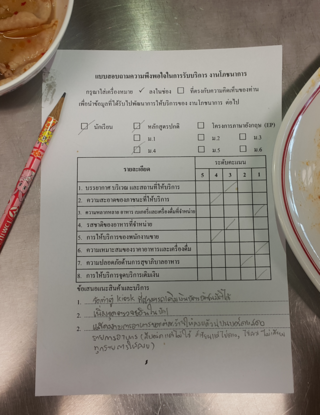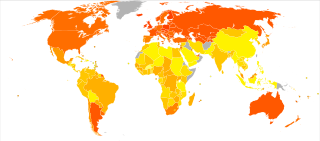Related Research Articles
A nutrient is a substance used by an organism to survive, grow and reproduce. The requirement for dietary nutrient intake applies to animals, plants, fungi and protists. Nutrients can be incorporated into cells for metabolic purposes or excreted by cells to create non-cellular structures such as hair, scales, feathers, or exoskeletons. Some nutrients can be metabolically converted into smaller molecules in the process of releasing energy such as for carbohydrates, lipids, proteins and fermentation products leading to end-products of water and carbon dioxide. All organisms require water. Essential nutrients for animals are the energy sources, some of the amino acids that are combined to create proteins, a subset of fatty acids, vitamins and certain minerals. Plants require more diverse minerals absorbed through roots, plus carbon dioxide and oxygen absorbed through leaves. Fungi live on dead or living organic matter and meet nutrient needs from their host.

Human nutrition deals with the provision of essential nutrients in food that are necessary to support human life and good health. Poor nutrition is a chronic problem often linked to poverty, food security, or a poor understanding of nutritional requirements. Malnutrition and its consequences are large contributors to deaths, physical deformities, and disabilities worldwide. Good nutrition is necessary for children to grow physically and mentally, and for normal human biological development.

Chocolate milk is a type of flavoured milk made by mixing cocoa solids with milk. It is a food pairing in which the milk's mouthfeel masks the dietary fibres of the cocoa solids.
In the U.S. and Canada, the Reference Daily Intake (RDI) is used in nutrition labeling on food and dietary supplement products to indicate the daily intake level of a nutrient that is considered to be sufficient to meet the requirements of 97–98% of healthy individuals in every demographic in the United States. While developed for the US population, it has been adopted by Canada.

A questionnaire is a research instrument that consists of a set of questions for the purpose of gathering information from respondents through survey or statistical study. A research questionnaire is typically a mix of close-ended questions and open-ended questions. Open-ended, long-term questions offer the respondent the ability to elaborate on their thoughts. The Research questionnaire was developed by the Statistical Society of London in 1838.

A healthy diet is a diet that maintains or improves overall health. A healthy diet provides the body with essential nutrition: fluid, macronutrients such as protein, micronutrients such as vitamins, and adequate fibre and food energy.
Specific dynamic action (SDA), also known as thermic effect of food (TEF) or dietary induced thermogenesis (DIT), is the amount of energy expenditure above the basal metabolic rate due to the cost of processing food for use and storage. Heat production by brown adipose tissue which is activated after consumption of a meal is an additional component of dietary induced thermogenesis. The thermic effect of food is one of the components of metabolism along with resting metabolic rate and the exercise component. A commonly used estimate of the thermic effect of food is about 10% of one's caloric intake, though the effect varies substantially for different food components. For example, dietary fat is very easy to process and has very little thermic effect, while protein is hard to process and has a much larger thermic effect.

Sports nutrition is the study and practice of nutrition and diet with regards to improving anyone's athletic performance. Nutrition is an important part of many sports training regimens, being popular in strength sports and endurance sports. Sports nutrition focuses its studies on the type, as well as the quantity of fluids and food taken by an athlete. In addition, it deals with the consumption of nutrients such as vitamins, minerals, supplements and organic substances that include carbohydrates, proteins and fats.

Proteins are essential nutrients for the human body. They are one of the building blocks of body tissue and can also serve as a fuel source. As a fuel, proteins provide as much energy density as carbohydrates: 17 kJ per gram; in contrast, lipids provide 37 kJ per gram. The most important aspect and defining characteristic of protein from a nutritional standpoint is its amino acid composition.
A diabetic diet is a diet that is used by people with diabetes mellitus or high blood sugar to minimize symptoms and dangerous complications of long-term elevations in blood sugar.
The European Prospective Investigation into Cancer and Nutrition (EPIC) study is a Europe-wide prospective cohort study of the relationships between diet and cancer, as well as other chronic diseases, such as cardiovascular disease. With over half a million participants, it is the largest study of diet and disease to be undertaken.
The Dietary Approaches to Stop Hypertension or the DASH diet is a diet to control hypertension promoted by the U.S.-based National Heart, Lung, and Blood Institute, part of the National Institutes of Health (NIH), an agency of the United States Department of Health and Human Services. The DASH diet is rich in fruits, vegetables, whole grains, and low-fat dairy foods. It includes meat, fish, poultry, nuts, and beans, and is limited in sugar-sweetened foods and beverages, red meat, and added fats. In addition to its effect on blood pressure, it is designed to be a well-balanced approach to eating for the general public. DASH is recommended by the United States Department of Agriculture (USDA) as a healthy eating plan. The DASH diet is one of three healthy diets recommended in the 2015–20 U.S. Dietary Guidelines, which also include the Mediterranean diet and a vegetarian diet. The American Heart Association (AHA) considers the DASH diet "specific and well-documented across age, sex and ethnically diverse groups."

The Western pattern diet is a modern dietary pattern that is generally characterized by high intakes of pre-packaged foods, refined grains, red meat, processed meat, high-sugar drinks, candy and sweets, fried foods, industrially produced animal products, butter and other high-fat dairy products, eggs, potatoes, corn, and low intakes of fruits, vegetables, whole grains, pasture-raised animal products, fish, nuts, and seeds.
The Dietary Guidelines for Americans (DGA) provide nutritional advice for Americans who are healthy or who are at risk for chronic disease but do not currently have chronic disease. The Guidelines are published every five years by the US Department of Agriculture, together with the US Department of Health and Human Services. Notably, the most recent ninth edition for 2020–25 includes dietary guidelines for children from birth to 23 months. In addition to the Dietary Guidelines per se, there are additional tools for assessing diet and nutrition, including the Healthy Eating Index (HEI), which can be used to assess the quality of a given selection of foods in the context of the Dietary Guidelines. Also provided are additional explanations regarding customization of the Guidelines to individual eating preferences, application of the Guidelines during pregnancy and infancy, the USDA Nutrition Evidence Systematic Review, information about the Nutrition Communicators Network and the MyPlate initiative, information from the National Academies about redesigning the process by which the Dietary Guidelines for Americans are created, and information about dietary guidelines from other nations.

Diet plays an important role in the genesis of obesity. Personal choices, food advertising, social customs and cultural influences, as well as food availability and pricing all play a role in determining what and how much an individual eats.
Food frequency questionnaire (FFQ) is a dietary assessment tool delivered as a questionnaire to estimate frequency and, in some cases, portion size information about food and beverage consumption over a specified period of time, typically the past month, three months, or year. FFQs are a common dietary assessment tool used in large epidemiologic studies of nutrition and health. Examples of usage include assessment of intake of vitamins and other nutrients, assessment of the intake of toxins, and estimating the prevalence of dietary patterns such as vegetarianism.
Research into food choice investigates how people select the food they eat. An interdisciplinary topic, food choice comprises psychological and sociological aspects, economic issues and sensory aspects.

Added sugars or free sugars are sugar carbohydrates added to food and beverages at some point before their consumption. These include added carbohydrates, and more broadly, sugars naturally present in honey, syrup, fruit juices and fruit juice concentrates. They can take multiple chemical forms, including sucrose, glucose (dextrose), and fructose.

Sugar-sweetened beverages (SSB) are beverages with added sugar. They have been described as "liquid candy". Added sugars include brown sugar, corn sweetener, corn syrup, dextrose, fructose, high fructose corn syrup, honey, invert sugar, lactose, malt syrup, maltose, molasses, raw sugar, sucrose, trehalose, and turbinado sugar. Naturally occurring sugars, such as those in fruit or milk, are not considered to be added sugars. Free sugars include monosaccharides and disaccharides added to foods and beverages by the manufacturer, cook or consumer, and sugars naturally present in honey, syrups, fruit juices and fruit juice concentrates.
Gladys Block is a nutrition researcher who worked at the National Cancer Institute.
References
- 1 2 3 4 5 6 7 "24-hour diet recall". Medanth. Retrieved January 3, 2017.
- 1 2 3 Wrieden, Wendy; Peace, Heather; Armstrong, Julie; Barton, Karen. "A short review of dietary assessment methods used in National and Scottish Research Studies" (PDF).
- 1 2 3 "24-hour Dietary Recall (24HR) At a Glance". National Cancer Institute . Retrieved January 3, 2017.
- ↑ Grewal, NK; Mosdøl, A; Aunan, MB; Monsen, C; Torheim, LE (2014). "Development and Pilot Testing of 24-Hour Multiple-Pass Recall to Assess Dietary Intake of Toddlers of Somali- and Iraqi-Born Mothers Living in Norway". Nutrients. 6 (6): 2333–47. doi: 10.3390/nu6062333 . PMC 4073154 . PMID 24949548.
- ↑ Willett, Walter (2001). "Invited Commentary: A Further Look at Dietary Questionnaire Validation". American Journal of Epidemiology . 154 (12): 1100–1102. doi: 10.1093/aje/154.12.1100 . PMID 11744512.
- ↑ "Principles and recommendations from NCI". NIH . Retrieved January 10, 2017.
- ↑ "Food Frequency Questionnaire at a Glance". National Cancer Institute, National Institutes of Health . Retrieved January 8, 2017.
- ↑ "Food Frequency Questionnaires" (PDF). University of Colorado Denver . Retrieved January 9, 2017.
- ↑ Moghames, Patricia; Hammami, Nour; Hwalla, Nahla; Shoaib, Hikma; Nasreddine, Lara; Naja, Farah (2015). "Validity and reliability of a food frequency questionnaire to estimate dietary intake among Lebanese children". Nutrition Journal . 15: 4. doi: 10.1186/s12937-015-0121-1 . PMC 4709981 . PMID 26753989.
- ↑ Vioque, Jesús; Navarrete-Muñoz, Eva-María; Gimenez-Monzó, Daniel; García-de-la-Hera, Manuela; Granado, Fernando; Young, Ian S; Ramón, Rosa; Ballester, Ferran; Murcia, Mario; Rebagliato, Marisa; Iñiguez, Carmen (2013). "Reproducibility and validity of a food frequency questionnaire among pregnant women in a Mediterranean area". Nutrition Journal . 12: 26. doi: 10.1186/1475-2891-12-26 . PMC 3584829 . PMID 23421854.